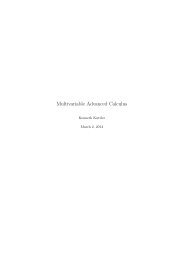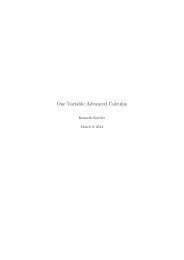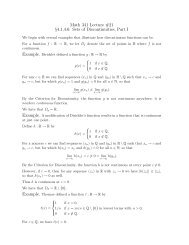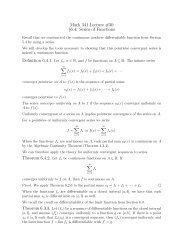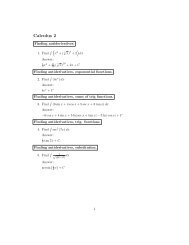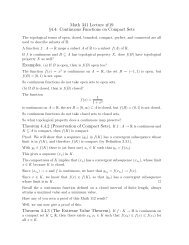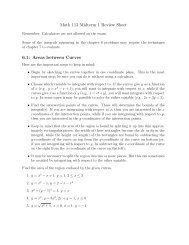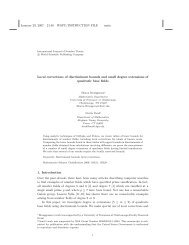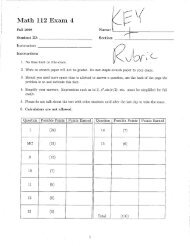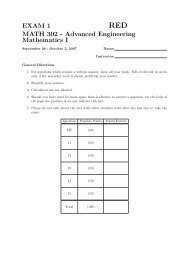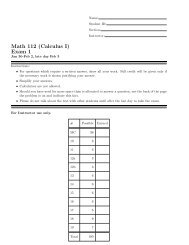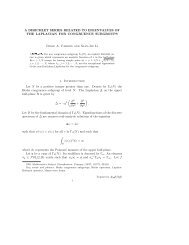You also want an ePaper? Increase the reach of your titles
YUMPU automatically turns print PDFs into web optimized ePapers that Google loves.
7Definition 1.9 Let E be a subset of X. Ē is defined to be the smallest closed set containing E. Note thatthis is well defined since X is closed and the intersection of any collection of closed sets is closed.Theorem 1.10 E = E ∪ {limit points of E}.Proof: Let x ∈ E and suppose that x /∈ E. If x is not a limit point either, then there exists an openset, U,containing x which does not intersect E. But then U C is a closed set which contains E which doesnot contain x, contrary to the definition that E is the intersection of all closed sets containing E. Therefore,x must be a limit point of E after all.Now E ⊆ E so suppose x is a limit point of E. We need to show x ∈ E. If H is a closed set containingE, which does not contain x, then H C is an open set containing x which contains no points of E other thanx negating the assumption that x is a limit point of E.Definition 1.11 Let X be a set and let d : X × X → [0, ∞) satisfyd(x, y) = d(y, x), (1.3)d(x, y) + d(y, z) ≥ d(x, z), (triangle inequality)Such a function is called a metric. For r ∈ [0, ∞) and x ∈ X, defineThis may also be denoted by N(x, r).d(x, y) = 0 if and only if x = y. (1.4)B(x, r) = {y ∈ X : d(x, y) < r}Definition 1.12 A topological space (X, τ) is called a metric space if there exists a metric, d, such that thesets {B(x, r), x ∈ X, r > 0} form a basis for τ. We write (X, d) for the metric space.Theorem 1.13 Suppose X is a set and d satisfies (1.3)-(1.4). Then the sets {B(x, r) : r > 0, x ∈ X} forma basis for a topology on X.Proof: We observe that the union of these balls includes the whole space, X. We need to verify thecondition concerning the intersection of two basic sets. Let p ∈ B (x, r 1 ) ∩ B (z, r 2 ) . Considerand suppose y ∈ B (p, r) . Thenr ≡ min (r 1 − d (x, p) , r 2 − d (z, p))d (y, x) ≤ d (y, p) + d (p, x) < r 1 − d (x, p) + d (x, p) = r 1and so B (p, r) ⊆ B (x, r 1 ) . By similar reasoning, B (p, r) ⊆ B (z, r 2 ) . This verifies the conditions for this setof balls to be the basis for some topology.Theorem 1.14 If (X, τ) is a metric space, then (X, τ) is Hausdorff, regular, and normal.Proof: It is obvious that any metric space is Hausdorff. Since each point is a closed set, it suffices toverify any metric space is normal. Let H and K be two disjoint closed nonempty sets. For each h ∈ H, thereexists r h > 0 such that B (h, r h ) ∩ K = ∅ because K is closed. Similarly, for each k ∈ K there exists r k > 0such that B (k, r k ) ∩ H = ∅. Now letU ≡ ∪ {B (h, r h /2) : h ∈ H} , V ≡ ∪ {B (k, r k /2) : k ∈ K} .then these open sets contain H and K respectively and have empty intersection for if x ∈ U ∩ V, thenx ∈ B (h, r h /2) ∩ B (k, r k /2) for some h ∈ H and k ∈ K. Suppose r h ≥ r k . Thend (h, k) ≤ d (h, x) + d (x, k) < r h ,a contradiction to B (h, r h ) ∩ K = ∅. If r k ≥ r h , the argument is similar. This proves the theorem.



